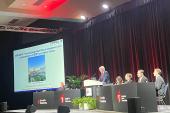IMPLEMENT-HF: ‘Virtual’ Stewardship May Help Optimize GDMT in HFrEF
Compared with usual care, an unseen team communicating with physicians increased new and intensified drug changes.

NEW ORLEANS, LA—A virtual hospital team who never meets their patients may have a behind-the-scenes role to play in getting them on optimal doses of guideline-directed medical therapy (GDMT) for heart failure with reduced ejection fraction (HFrEF), even if their reason for admission has nothing to do with HF, results of the IMPLEMENT-HF trial suggest.
Some recent trials, including BETTER CARE-HF and PROMPT-HF, have shown how pop-ups in electronic health records (EHRs) can be used to nudge physicians to optimize their HFrEF patients to the so-called “four pillars” of GDMT (an angiotensin receptor-neprilysin inhibitor (ARNI), a beta-blocker, a mineralocorticoid receptor antagonist (MRA), and a sodium-glucose cotransporter 2 (SGLT2) inhibitor). Other recent efforts have explored the potential for using noncardiac hospital admissions to trigger a check-in on heart failure meds.
Many of these interventions, however, raise concerns about alert fatigue, despite their intention of being less resource-intensive than other GDMT-optimization concepts. For example, the recent STRONG-HF trial, while successful, required weekly check-ins with patients, said IMPLEMENT-HF lead author Ankeet S. Bhatt, MD (Brigham and Women's Hospital, Boston, MA), who presented the study results last week at the American College of Cardiology/World Congress of Cardiology (ACC/WCC) 2023 meeting. They were simultaneously published in the Journal of the American College of Cardiology.
“We were really interested in a middle ground,” he told TCTMD, noting that for the virtual team component they took inspiration from virtual anticoagulation management services and antibiotic stewardship teams, which are already in place in many hospitals and healthcare systems.
“Our rationale was a strategy that we thought could be scalable to other healthcare systems and that would hopefully have larger, absolute effect sizes than some electronic-based nudges,” Bhatt explained.
Compared with HFrEF patients randomized to usual care, those enrolled in the virtual care team-guided strategy while hospitalized had greater improvement in GDMT prescribing. There was a near doubling of the number of new drug initiations (P = 0.001) and intensification of one or more GDMT components (P = 0.001).
In many cases the physicians receiving these virtual care suggestions were noncardiovascular specialists [with] limited knowledge about some of the newer medications available in the treatment of heart failure. Ankeet S. Bhatt
“This was a hospitalized cohort and therefore in-hospital adverse events were common, occurring in about 25% of participants,” Bhatt said in his presentation. “However, we did not observe an excess risk in adverse events as adjudicated by a clinical endpoints committee amongst those allocated to the virtual care team arm versus usual care. Hospital length of stay was a median of 6 days amongst those allocated to the usual care arm and 6 days amongst those allocated to the virtual care team strategy.”
Better GDMT Optimization Scores Seen
The study took place at three centers within a single integrated healthcare system: an academic medical center, a community teaching hospital, and a nonteaching community hospital. Patients with an EF of 40% or less (mean age 69 years; 34% women; 14% Black; 17% Hispanic) were randomized to virtual care (n = 83 patients) or usual care (n = 115 patients), with many patients having multiple physician encounters, adding up to a total of 107 virtual-care and 145 usual-care encounters. A diagnosis of heart failure was the primary reason for admission in just 25% of patients and for approximately one in five patients, this was the first time they’d been diagnosed with heart failure.
The virtual care team consisted of a CV-trained physician and a pharmacist who identified potentially eligible HFrEF patients through their EHR. If the treating physician had no reason to exclude the patient from the intervention, the virtual care team would use an algorithm based on the most recent guidelines from the American College of Cardiology/American Heart Association/Heart Failure Society of America.
GDMT optimization suggestions were communicated through progress notes in the EHR. These notes included instructions about dosing, follow-up monitoring, risk of adverse effects, information about efficacy of the recommended drug in HFrEF, and a contact if the physician wanted to discuss the recommendations, although there was no patient contact with virtual care team members. Physicians had full discretion about whether or not to adopt the suggestions, but were instructed to paste a paragraph into the patient’s discharge instructions if they did, explaining that a “special heart failure quality-improvement team” had been involved in their medication changes.
The primary endpoint was an in-hospital GDMT optimization score. The score ranged from -8, indicating a patient hospitalized on full quadruple therapy but discharged on no therapy, up to +8, indicating a patient hospitalized on no therapy then discharged on full quadruple therapy.
The mean GDMT summary score was 0.4 in the usual-care group versus 1.1 in the virtual-care group, a difference that was significant (P < 0.001).
There was a 22% absolute increase in the proportion of encounters with at least one new initiation or meaningful dose uptitration, a 21% absolute increase in the proportion of encounters in which there was a new initiation of drug, and a 20% absolute increase in the proportion of encounters in which patients left the hospital on more GDMT than they had arrived on.
The results were consisted across major subgroups, care sites, chronicity of HF, and reason for hospitalization.
While the between-group differences in the proportion of new initiations for ACE inhibitors or ARBs, ARNIs, and SGLT2 inhibitors were not significant, the virtual-care group had greater new initiation of beta-blockers (81% vs 44%; P = 0.005) and MRAs (32% vs. 11%; P = 0.001) than the usual-care group.
Adverse safety events included acute kidney injury, bradycardia, hypotension, and hyperkalemia, and were not different between the virtual- or usual-care groups (P = 0.30).
Questions Remain
IMPLEMENT-HF senior author Muthiah Vaduganathan, MD, MPH (Brigham and Women's Hospital, Boston, MA), told TCTMD the study demonstrates that episodes of hospitalization offer an ideal setting to assess and improve the quality of medical therapy optimization.
“These episodes of care allow for rapid titration of GDMT in a highly monitored environment,” he added. “Leveraging expertise and input from multidisciplinary teams, especially in navigating cost and access barriers, may help ensure patients leave the hospital on optimal GDMT.”
Commenting in the session, panelist Biykem Bozkurt, MD, PhD (Baylor College of Medicine, Houston, TX), noted that about 75% of patients in IMPLEMENT-HF were hospitalized for some reason other than their heart failure, making this type of intervention potentially scalable across a range of disease states and diagnoses among HF patients. She added that the virtual care model seems to “connect the dots” between EHR alert-based models and those that are more resource intensive.
However, Bozkurt said it will also be important to understand why even a contactless intervention fails to motivate a physician to optimize GDMT, as well as whether there are improvements in providers’ knowledge bases such that after a certain number of virtual nudges they no longer need them.
Bhatt said his group is still looking at that information and can’t rule out the possibility that different centers and different mixes of clinicians may impact the success of a virtual care optimization program.
Anecdotally, he told TCTMD, physician feedback suggested that the explanations given by the virtual team were helpful with regard to certain therapies, “because in many cases the physicians receiving these virtual care suggestions were noncardiovascular specialists and therefore in some cases had limited knowledge about some of the newer medications available in the treatment of heart failure.”
L.A. McKeown is a Senior Medical Journalist for TCTMD, the Section Editor of CV Team Forum, and Senior Medical…
Read Full BioSources
Bhatt AS, Varshney AS, Moscone A, et al. Virtual care team-guided therapeutic optimization during hospitalization in patients with heart failure: the IMPLEMENT-HF study. J Am Coll Cardiol. 2023;Epub ahead of print.
Disclosures
- Bhatt reports no relevant conflicts of interest.





Comments